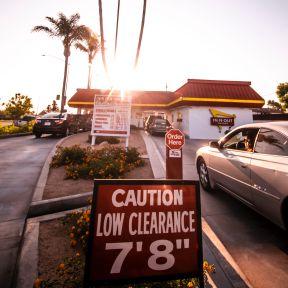The Illusion of Convenience: Why People Wait in Drive-Thrus Convenience is in the eye of the consumer. Reviewed by Jessica Schrader

KEY POINTS-
- Convenience may be real, but our perception of it may not be.
- Anchoring can create the paradox of saving in behavioral economics.
- The illusion of convenience can create a paradox of perception and choice.
Did you ever notice that fast food drive-thru lanes are a trap? Unless the line is already long and backed up around the curve, you can’t see how many cars are ahead of you. Once you’ve placed your order, you’re blocked from exiting by the vehicles in front of you and (soon) by those following you. And there’s a barrier that prevents exiting.
During peak lunch and dinner hours, it’s common to see long lines of cars, engines running, with people waiting patiently (more or less) for their food orders. Why not just park and go inside? During the pandemic, of course, restaurant lobbies were mostly closed. The drive-thru was the only option. But restaurants are open again. And besides, the question of why people endure waiting in long drive-thru lines precedes COVID-19.
Behavioral Economics
The drive-thru question is a bit like the paradox of savings in behavioral economics. Why will people drive 5 miles out of their way to save $10 on a toaster oven but not 5 miles out of their way to save $10 on the cost of a new car? Why will someone clip a $1 coupon for a box of cereal but not drive half a mile further to save the same $1 on a tank of gas? Rationally, the amount saved is the same. But the context is different.
The toaster-oven-versus-new-car example illustrates the power of the anchoring effect. A toaster oven normally sold for $50 but that is now on sale for $40 has a bigger psychological impact. The anchor price of $50 versus today’s sale price of $40 signals a huge savings (20%) as well as a fleeing opportunity (fear of missing out). The 5-mile drive pales in comparison. But suppose you have two offers on exactly the same car from two dealers—one located a mile from your home and the other 6 miles away. If the nearby dealer's price is only $10 more, why bother driving the 5 miles extra? A $10 savings on a $40,000 car sounds like pennies—and as a percentage of the total cost, it is (.00025). But in either case, 5 miles is 5 miles, and $10 is $10.
The Illusion of Convenience
Fast-food restaurants know that there’s a point beyond which people will not put up with slow drive-thru lines. Some of us have reached that point long ago and avoid drive-thrus like the plague unless we know there’s no line. I mostly avoid fast food anyway, but when I do go there, my limit is two cars ahead. More than that and I’ll either go inside or eat somewhere else.
When I was teaching college business courses, I presented the case of McDonald’s testing call centers to take drive-thru orders. In some markets, a drive-thru customer would speak not to an employee of his or her local restaurant, but to a call center employee several states away. The order would be relayed electronically to the restaurant, and this would allow staff to focus on preparing food and filling orders. What if McDonald’s could eliminate order-taker jobs from hundreds of restaurants and replace those workers with a few dozen call center employees? The drive-thrus would move faster (at least theoretically), and the company would save money. Now fast-food chains are experimenting with AI to take orders and speed delivery.
Gürhan-Canli and Irmak (2012) explore the illusion of convenience for consumers when corporations use behavioral cues and technology to channel shopping and buying behavior. The authors examine the psychological and behavioral effects of this illusion and discuss the potential negative consequences for consumers' well-being and social interactions. For example, a recent CNN article reports that drive-thrus are creating problems for cities and towns. They contribute to traffic and congestion to such as degree that some cities—even notoriously sprawl-loving Atlanta—have begun to ban them in newly constructed restaurants (Meyersohn, 2023).
The illusion of convenience embodied in drive-thrus also raises another paradox for behavioral economics: Why will people park and go inside convenience stores—many of which sell food items similar to the offerings of fast food restaurants—but not do the same at a quick-serve restaurant? In one context, going inside is framed in the consumer’s mind as “convenient,” but in the other it is not. Fast-food restaurants did this to themselves. In the days before drive-thrus were ubiquitous, ordering at the counter inside a McDonald's or similar chain was considered the ultimate in mealtime convenience. Go figure.
- Questions and Answers
- Opinion
- Motivational and Inspiring Story
- Technology
- Live and Let live
- Focus
- Geopolitics
- Military-Arms/Equipment
- Segurança
- Economy
- Beasts of Nations
- Machine Tools-The “Mother Industry”
- Art
- Causes
- Crafts
- Dance
- Drinks
- Film/Movie
- Fitness
- Food
- Jogos
- Gardening
- Health
- Início
- Literature
- Music
- Networking
- Outro
- Party
- Religion
- Shopping
- Sports
- Theater
- Health and Wellness
- News
- Culture

